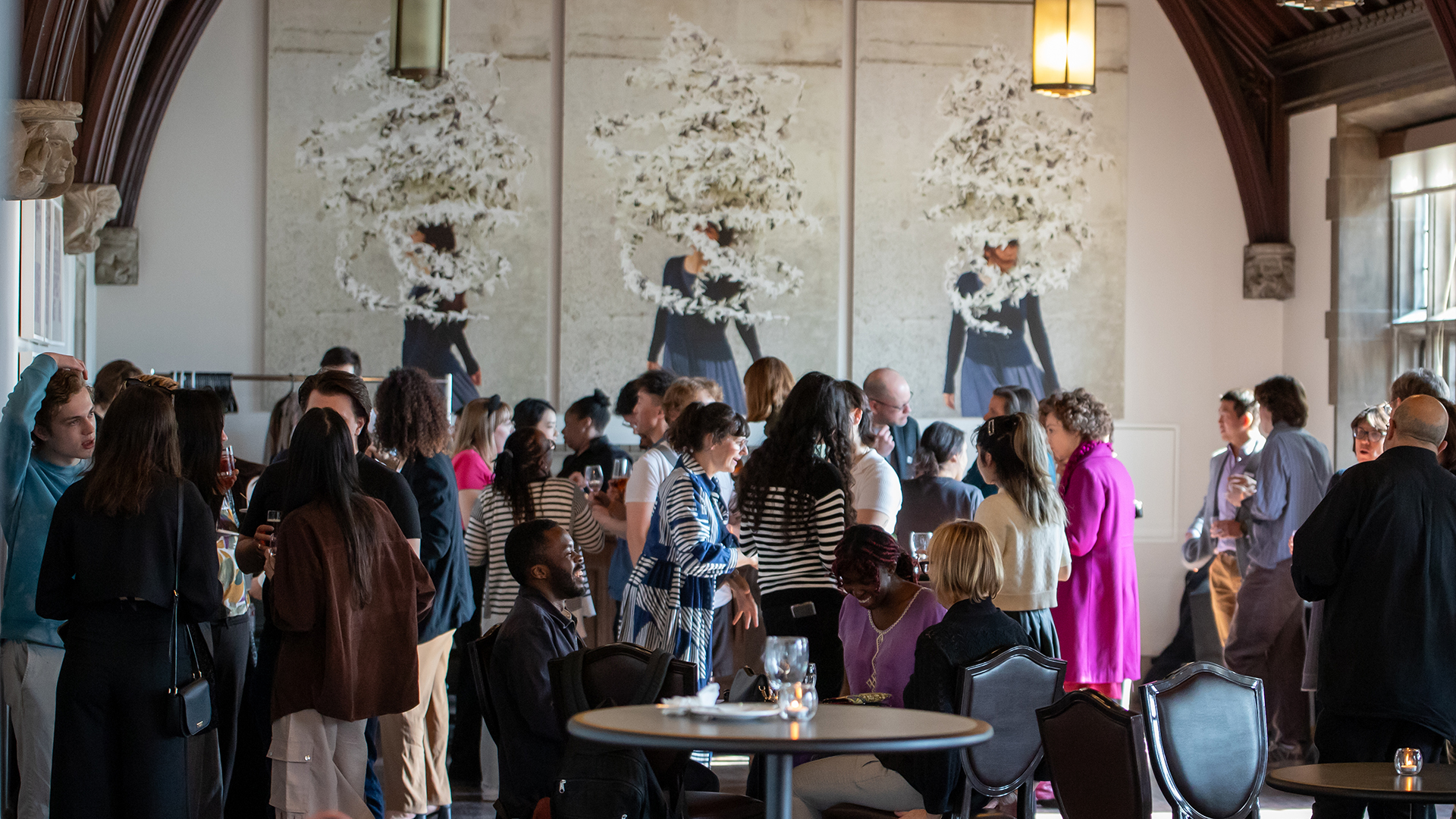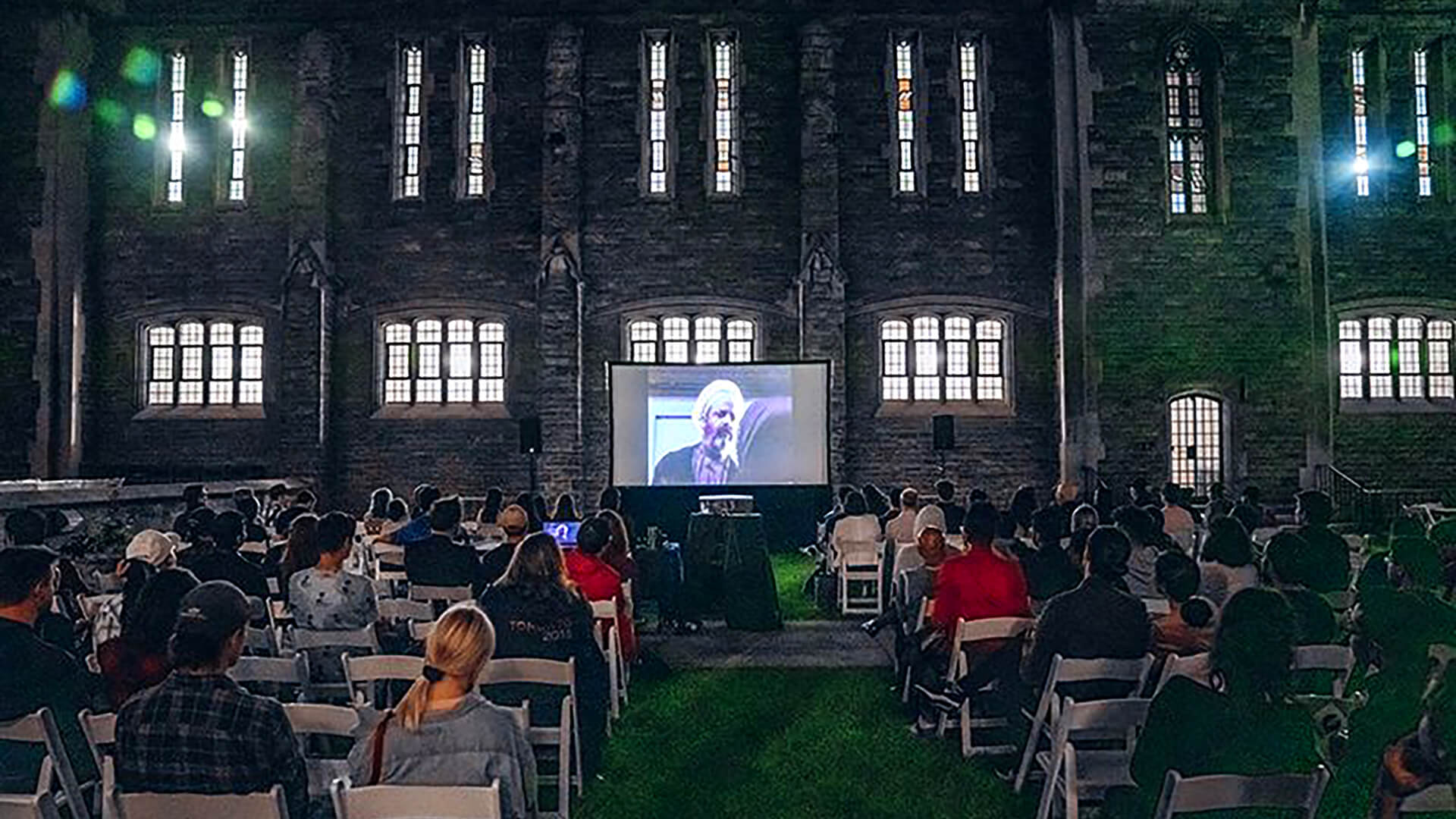The art collection at Hart House is a stunning cornucopia of Canadian works, filled with hidden gems by some of the nation’s greatest visual artists. Students, alumni and community members can commune with this awe-inspiring work on the walls and grounds of Hart House, each and every day, gaining an insider’s look as to the scale and scope of this impressive collection.
The Hart House Art Collection is a body of work by Canadian artists, spanning just over a century – arguably, a must-see for all art lovers on U of T’s St. George Campus. A brilliantly curated selection of acquired works are on display at Hart House year-round, while others circulate in exhibitions across the country and around the world.
The Collection is cared for and developed by the Art Museum (Justina M. Barnicke Gallery and University of Toronto Art Centre), working with the Student Art Acquisition Committee.

Engaging students in the appreciation of the art collection, and the visual arts as a whole, has been a core part of Hart House's work. Saša Rajšić, who commenced his role as Coordinator, Integrated Arts Education, in July 2022, serves as the staff advisor on the Hart House Student Art Committee. “This Committee began working 100 years ago. It’s one of the oldest student-run art committees in the country,” he says.
“The Hart House Student Art Committee includes students from different disciplines, different programs, not only art-based majors. This is great because it's opening this field up to a lot of students, many of whom have very little familiarity with artwork,” he adds.
Key facts about the Hart House Art Collection:
- The Collection is 100 years old; it began in 1922.
- The criteria: From the very beginning of the Collection, the mandate has been to purchase works by living Canadian artists or artists residing in Canada in order to support them.
- The Collection contains approximately 717 works.
- The first purchase was an A. Y. Jackson work in 1922: “Georgian Bay, November.”
- There are four works in the Collection that pre-date the 20th century. (Two Cornelius Krieghoff pieces, donated to the Collection in the 1950s, are the oldest works, dating back to 1860. However, they are anomalous because the mandate of the Collection, as noted, is to acquire works by living artists.
- A curated selection of approximately 70 pieces is on display around Hart House. (Items not on display are in secure, Museum-standard storage.)

Collection is Wide-Ranging with Indigenous and Female Artists Well Represented
The artwork ranges from figurative to abstract and conceptual, including mixed media, photography and sculpture. Its particular strengths are in the early 20th century and works created in the 1960s through 1980s, a time when Canadian art, some would argue, came into its own and truly flourished.
“Our Collection is quite significant, historical. We have a lot of important historic pieces, such as works by members of the Group of Seven, as well as contemporary artwork,” Saša explains. “The Collection is also living, in that it travels. A piece by Denyse Thomasos is currently on loan to the Art Gallery of Ontario, for example.”

Impressively, as Saša mentions, the Collection contains a number of great works by members of the Group of Seven – Franklin Carmichael, A. J. Casson, Lionel LeMoine FitzGerald, Lawren Harris, A. Y. Jackson, Arthur Lismer, J. E. H. MacDonald and Frederick H. Varley, as well as Tom Thomson, who was not in the group but is so often associated with it.
Other household names in Canadian art present in the Collection include Jack Bush, Charles Comfort, Andy Fabo, Gershon Iskowitz, David Milne, James Wilson Morrice, Kazuo Nakamura, Christopher Pratt, William Ronald, Carl Schaefer, Harold Town and General Idea.
French Canadian legends in Abstract art – Paul-Émile Borduas and Jean-Paul Riopelle to name a few – are also featured.
Female artists are well represented in the Collection. They include those active in the early 20th century who were ‘rediscovered’ in the 1980s as essential innovators: Paraskeva Clark, Prudence Heward, Yvonne McKague Housser, Pegi Nicol MacLeod, Isabel McLaughlin, Lilias Torrance Newton and Anne Savage. Works of well-known female artists of the last 40 years are also in the Collection. This list includes Wanda Koop, Liz Magor, Mary Pratt, Christiane Pflug, Joanne Tod and Joyce Wieland.
Esteemed Indigenous artists, such as Carl Beam, Norval Morrisseau and Jane Ash Poitras are also encompassed.

A major, groundbreaking work was commissioned in 2019: "waabidiziiyan doopwining” (to see yourself at the table) is a site-specific work by Indigenous artists Rebecca Belmore and Osvaldo Yero. Situated in the Great Hall, this work is the Hart House Centennial Art Commission, part of the 100th anniversary of Hart House, representing our commitment to reconciliation and decolonization, and a redress to the early history of the Collection. (The Hart House Student Art Committee was not involved in this commission.)
Evolution of the Collection Reflects Desire to Counter Prevailing Canons
It is interesting to step back and note the evolution of the Collection over time. In the mid-20th century, for example, it focused in part on the Toronto-based Abstract artists associated with the Painters Eleven, such as the aforementioned Jack Bush and William Ronald, as well as on the Montreal-based Automatists.

More recently, however, the Collection has sought to acquire the work of living, emerging and mid-career artists of First Nations and culturally diverse backgrounds, to counter prevailing canons and mythologies of identity and history in Canadian art. The Collection has also sought to acquire the creations of artists working in a greater diversity of media, including language-based works, photography, video and installation.

Inclusive of broader gender and cultural identities, as well as artistic forms, the current selection of works features Toronto-based artists such as Wendy Coburn, Erika DeFreitas, Jalani Morgan, Jon Sasaki, and Laurel Woodcock, as well as artists from across the country, including Stan Douglas, Ken Lum, Divya Mehra and Adrian Stimson ‒ one of Saša’s favourite.
About the image to the left: Saša Rajšić in the Committees Room in front of one of his favourite pieces in the Hart House Art Collection: Indigenous artist Adrian Stimson’s photographs. Left to right: “Buffalo Boy Dance Sashay” (2004); “Shaman Exterminator Hide” (2006); “Shaman Exterminator Sunrise” (2006); “Shaman Exterminator” (2004); and “Buffalo Boy” (2004).
Committee Members Tour Galleries, Studios and Museums
Seeking to expose Committee members to cutting-edge, up-and-coming artists; contemporary art and artistic practices in Canada; and to give them an idea of how arts organizations are run, Saša coordinates tours of museums, art galleries and studios.
He seeks to nurture an appreciation for visual arts. “My goal is to get the students excited and educated and give them a lot of experience and exposure to art. I also want them to hear, from an artist’s perspective, what it means to have their artwork collected,” he says, adding, “It's quite a big deal when your work is acquired in a public art collection like the Hart House Art Collection.”
Visitors to Hart House can See these Works Up Close and In Person
Over 70 pieces are on display around Hart House, as mentioned. The House encourages all students, alumni and community members to come and see these works in person, or visit the website for a more fulsome look at the entire Collection.
This brochure from 2019 is excellent because it shows visitors to Hart House exactly where to find the works. That said, some artwork may have changed locations since 2019.An updated brochure is planned for the new year.
Learn more about the Hart House Student Art Committee ‒ workshops, the gallery tours and outings.
Did you enjoy this article? If so, be sure to sign up to receive the Hart House Quarterly, our publication which regularly offers captivating stories about our remarkable students and staff members, facilities, opportunities and programs.





